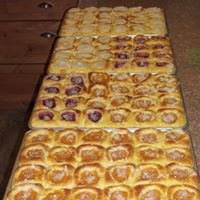Sunday evening, I heard something that sounded an awful lot like thunder. Hmmm, I turned off the sound of the pre-Oscar show and listened. Sure enough, very clearly, I heard thunder. I believe it was Mrs. Georgia Vittitow, God rest her soul, who stated, “A thunderstorm in February means a freeze on the same date in April.” As the sole owner of a struggling vineyard in Rains County, I surely hope she was wrong, and that there won’t be a freeze on April 26. That would be devastating.
But, that had me thinking of other “old timers,” their “sayings” and how knowledge is passed, sometimes incorrectly.
I’m a third-generation Czech-American. My parents were both ESL (English as a second language) students. They didn’t have an acronym in those days, but they were the kids in the country school houses that spoke a different language at home and then learned English as they attended school. In those days it was no big deal and everyone learned English if they attended school.
I grew up and attended public schools in Arlington, certainly speaking English, but still submersed in a Czech-induced life. I grew up with traditional Czech cooking – and certainly kolache.
So, I know what a kolach is. Kolach comes from a Czech word meaning circle or wheel. It is a soft buttery pastry, usually filled with a fruit center.
The plural form of kolach is kolache. It is not cylindrical and it does not surround a sausage. However, popular in Texas, the fabulous treat with a sausage encompassed in dough is something different.
I asked my mother about it, since I kept hearing non-Czechs call them kolaches. My mom surmised that it would be very possible for leftover kolach dough to be used to make a kind of sandwich with leftovers, even sausage. It’s not a kolach – just as a hotdog rolled up in a tortilla isn’t a burrito. However, the item could have been taken to the field as a Czech-like sandwich.
When I pushed her and my dad for a name for this sausage-rolled-in-dough thing, they came up with klobasnik, or in plural, klobasniky. A klobasnik is an American creation. In the now Czech Republic or Slovakia, it isn’t a “thing.” If you tried to order one while visiting in Europe, they’d probably be confused. The confusion probably came about when some poor Czech took his simple leftover sandwich to work. Then when struggling to converse with others and with the language barrier, it may have been called a kolach. The Czech-American would have agreed that yes, in a way, it was. Thus began an annoying misunderstanding – okay, at least for me and possibly other Czech-Americans.
I make klobasniky for Reka’s Rise and Shine and other coffee shops. They seem to be well liked. I hear them referred to as “pig-in-a-blankets” and that doesn’t do them justice. Any hotdog rolled in biscuit dough could be called that.
A klobasnik should be made with the best quality sausage link that can be found, rolled in a buttery sweet-roll dough, cooked until perfectly golden-brown and finished by basting with butter.
I won’t give away my Czech grandmothers’ recipes, but here’s a kolach recipe that has been published in Texas Highways. It is pretty good, and worth a try.
Kolache*
1 c. sour cream
1/2 c. sugar
1-1/2 tsp. salt
1/2 c. butter
2 pkg. dry yeast
1/2 c. warm water
2 eggs, beaten
4 c. all-purpose flour
fruit filling
posipka filling
1/3 c. additional butter, melted
Heat sour cream until warm, Stir in sugar, salt and softened butter. Set aside to cool.
Sprinkle yeast over warm water. Let stand until yeast dissolves. Add to sour cream mixture. Add eggs and flour. Mix well until the dough is spongy. Cover and refrigerate overnight.
Remove from the refrigerator and shape dough into egg-sized balls. Flatten into 1/2-inch thick and let rise for 10 minutes on a lightly-greased cookie sheet.
Make indentions in the middle of each ball. Add fruit filling. Sprinkle posipka over the top.
Let kolache rise until doubled. Bake at 350 degrees for 25 minutes or until golden brown. Remove from oven and brush the edges with melted butter.
* Notice there’s no “s” at the end – kolache is plural.
Fruit Filling
2 12-oz pkgs. dried fruit like pitted plums or apricots
1/8 tsp. cinnamon
1/2 c. sugar
Cover fruit with water and cook 12-15 minutes, until tender. Drain.
Puree fruit in blender. Add cinnamon and sugar, blend until combined.
Posipka
2/3 c. all-purpose flour
1 c. sugar
1/3 c. butter, softened
Blend flour and sugar in a bowl. Cut in butter until crumbly.

